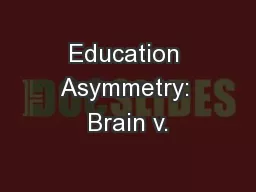PPT-Education Asymmetry: Brain v.
Author : karlyn-bohler | Published Date : 2018-03-21
Brawn in rural Communities Presented by Maggie Hutchison and Tess Hart Spring 2017 ECON 6460 Agriculture and Sustainable Development Adapted from MITs online micro
Presentation Embed Code
Download Presentation
Download Presentation The PPT/PDF document "Education Asymmetry: Brain v." is the property of its rightful owner. Permission is granted to download and print the materials on this website for personal, non-commercial use only, and to display it on your personal computer provided you do not modify the materials and that you retain all copyright notices contained in the materials. By downloading content from our website, you accept the terms of this agreement.
Education Asymmetry: Brain v.: Transcript
Download Rules Of Document
"Education Asymmetry: Brain v."The content belongs to its owner. You may download and print it for personal use, without modification, and keep all copyright notices. By downloading, you agree to these terms.
Related Documents














